|
|
|
Sort Order |
|
|
|
Items / Page
|
|
|
|
|
|
|
| Srl | Item |
| 1 |
ID:
172146
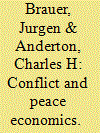

|
|
|
|
|
| Summary/Abstract |
In reviewing the sweep of the extant literature over the past century or so, we first define and present an overview and conceptual synthesis of the field of conflict economics with a special view toward the subfield of peace economics. We explain that standard textbook economics is a special case of conflict economics and discuss assumptions, subject matter, and interrelations between economics and conflict. We also briefly discuss the nature of the peace and security good, including transboundary and transgenerational aspects. Second, focusing on new research opportunities arising from behavioral, identity, and social network economics we identify entire branches of economic theory that have been little harvested as yet to help address important aspects of conflict and peace. We provide illustrative models, each tied to economics’ standard rational choice setup. Third, we reflect on the use of conflict-related datasets in empirical research, illustrated with examples pertaining to data validity, missing data, data merging, and data mining.
|
|
|
|
|
|
|
|
|
|
|
|
|
|
|
|
| 2 |
ID:
172143
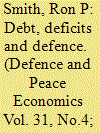

|
|
|
|
|
| Summary/Abstract |
Military spending associated with wars has been a major cause of government deficits and debt financing. This paper looks at the association between debt and defence spending in the UK over the last three centuries. The paper reviews the history, discusses the theory and provides some estimates of the effect of variations in military expenditure on debt. The association tends to be quite close and the effect of the change in the share of military spending in GDP on the debt–GDP ratio is quite stable.
|
|
|
|
|
|
|
|
|
|
|
|
|
|
|
|
| 3 |
ID:
172140
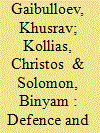

|
|
|
|
|
| Summary/Abstract |
Keeping with the established tradition in our journal, this paper reviews and surveys the last decade, that is volumes 21–30. It offers an overview of the thematic coverage of the papers published in Defence and Peace Economics and the changes that have occurred, points to existing gaps in the defence economics literature and possible future directions in the research agenda of this growing and vibrant field.
|
|
|
|
|
|
|
|
|
|
|
|
|
|
|
|
| 4 |
ID:
172144


|
|
|
|
|
| Summary/Abstract |
This paper contributes to the analysis of the impact of military spending and corruption on economic growth, by considering not only the political dimension of corruption, distorting the allocation of resources to sectors, but also the impact on the efficiency of the bureaucratic environment. It does this by developing the model of Mauro (2004) in the context of an endogenous growth model to deal with corruption in the defence sector. It then uses data from the International Country Risk Guide to produce a novel measure of corruption that combines corruption within the political system, institutional strength, quality of bureaucracy and the degree of military participation in the country and estimates the model for a large panel of countries. The results suggest that both military spending (as a share of total government spending) and corruption have significant negative long run effects on output. As the model also suggests that multiple equilibria can exist, a comparison is made between high and low corruption groups of countries and clear differences are indeed found. This suggests that effort is needed to encourage and coerce high corruption and military spending countries, but low corruption and military spending countries are likely to need little attention.
|
|
|
|
|
|
|
|
|
|
|
|
|
|
|
|
| 5 |
ID:
172142


|
|
|
|
|
| Summary/Abstract |
For 2011–2017, this paper revisits NATO burden sharing in light of recent developments and pledges to bolster members’ defense shares of GDP to 2%. Russian nationalism, enhanced transnational terrorism, and intrastate conflicts are apt to increase the publicness of NATO defense spending over the last eight years. When NATO allies’ defense shares of GDP are correlated with their GDP ranks, there is clear evidence of the exploitation of the large, rich allies by the small, poor allies, indicative of allies sharing purely public defense spending since 2011. Such exploitation and free riding has rarely been seen after 1967. In addition, there is an absence of concordance between NATO allies’ defense burdens and their derived benefit shares, consistent with greater defense publicness. Finally, we find further proof of exploitation and free riding for a broad-based measure of security spending.
|
|
|
|
|
|
|
|
|
|
|
|
|
|
|
|
| 6 |
ID:
172141
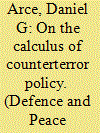

|
|
|
|
|
| Summary/Abstract |
In democratic societies, elections can act as a referendum on politicians’ counterterror policy. At the same time, counterterror policy is conducted under conditions of asymmetric information because the government is better informed about the nature of the threat than is the public. Using a hybrid signaling model, this paper characterizes counterterror policy in terms of its instrumental efficacy against terrorists, and also non-instrumental considerations such as the electoral consequences of policy failures. In addition, the equilibria capture the difficulties that voters have in assessing the appropriateness of policy in the absence of terrorism.
|
|
|
|
|
|
|
|
|
|
|
|
|
|
|
|
| 7 |
ID:
172145
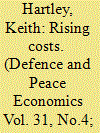

|
|
|
|
|
| Summary/Abstract |
Rising military equipment costs were famously identified by Norman Augustine with forecasts of a single aircraft air force by 2054. This paper presents and analyses an original data set for UK military aircraft. It provides evidence on cost escalation for various UK aircraft types comprising fighter/strike, bombers, military transports, maritime patrol aircraft, helicopters, trainers and civil aircraft. Continued cost escalation is identified for almost all types but with different cost escalation factors. It is concluded that the specific Augustine hypothesis of costs rising by a factor of four every 10 years might be an under-estimate.
|
|
|
|
|
|
|
|
|
|
|
|
|
|
|
|
|
|
|
|
|